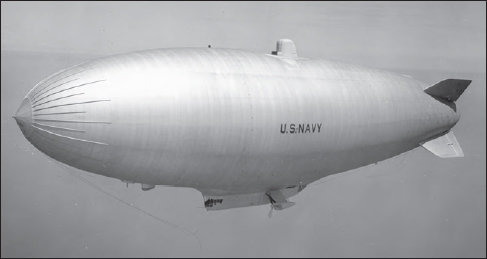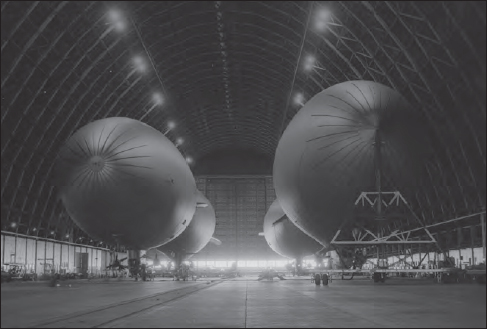One Hundred Years of U.S. Navy Air Power (12 page)
Read One Hundred Years of U.S. Navy Air Power Online
Authors: Douglas V. Smith


The U.S. Navy's largest non-rigid airships, the ZPG-3W class, flew until 1962
.
But, as noted LTA historian Richard K. Smith has written “The
Akron
had been pushed unreasonably hard, with unrealistic expectations, and her inability to score a smash hit which corresponded to the airship propaganda of 1926â1931 made her performance appear as something of a failure.”
8
In the fall and winter of 1932 she flew practice missions in which the Sparrowhawk airplanes left the hangar in the belly of the airship using a unique trapeze system to launch and recover while the airship maintained a steady course. The envisioned concept of operations was for the airship to drop two scout planes from the trapeze, and then proceed at sixty knots for up to twelve hours of daylight, recovering the airplanes 720 miles from the drop-off point. The LTA/HTA team could theoretically sweep a path 200 miles wide, covering over 140,000 square miles of ocean. The HTA detachments on both
Akron
and
Macon
became very proficient on the trapeze, so much so that landing gear was removed on some planes, to be replaced with supplemental gas tanks under the fuselage. The concept of the “flying aircraft carrier” was hampered by poor radio communications and direction-finding equipment on the aircraft, but the “wing-hookers” performed with great dexterity, much like their “tail-hooking” colleagues on traditional aircraft carriers. The
Akron
's continued development of these concepts was abruptly halted on 3 April 1933 when the ship encountered one of the most violent storm fronts to hit the east coast of the United States in a decade. The ship was forced into the sea, with the loss of seventy-three of the seventy-six crewmen aboard. Included in the death toll was Rear Admiral William A. Moffett, Chief of the Navy Bureau of Aeronautics, who had been a strong supporter of airships. The crash shocked the nation and rocked the Navy, particularly the crew of USS
Macon
, the sister ship that had been commissioned only weeks earlier on 11 March 1933. The fate of the Navy's rigid airship program now rested entirely on the untested
Macon
.
The
Macon
proved to be a strong and capable ship, and her move to her new base in Sunnyvale, California (rapidly named Moffett Field in honor of the deceased Admiral), enabled her to work directly with the ships of the Pacific Fleet.
Macon
's performance proved that large rigid airships could perform many of the missions expected of them, but on 12 February 1935, an unexpectedly strong gust of wind caused a failure in the rear upper fin area. As the stern dropped, ballast was released causing the ship to rise well above its maximum pressure height to over 4,800 feet. Automatic pressure relief valves opened to prevent the gas cells from exploding, and the large quantity of gas vented off made the ship too heavy to remain in the air. It touched down relatively gently on the ocean surface and eighty-one of the eighty-three crewmembers survived as the ship was abandoned. The days of Navy rigid airships immediately came to a close. Three of the U.S.-built rigids had crashed, and
the Navy walked away from the huge potential these ships held. Decades later, literally thousands of aircraft would be lost to accidents as the Navy transitioned from propeller aircraft to jet-propelled planes, yet development continued because of the great potential seen in the new technology. Perhaps the decision to end experimentation with rigid airships after three crashes was an ill-advised rush to judgment. Some historians have speculated that the surprise attack on Pearl Harbor could have been detected had a “flying aircraft carrier” and her scouting planes been on station.

BLIMPS . . . “THEY WERE DEPENDABLE”
while the Navy abandoned rigid airships in 1935 after the loss of
Macon
, it continued to operate small blimps into the 1940s. The smaller and less expensive blimps were seen as good observation platforms for coastal defense and as a potential partial answer to the threat of enemy submarines. As war clouds gathered in the Atlantic and Pacific, the nation prepared by ordering the procurement of forty-eight non-rigid blimps as part of the “10,000 Plane Program” passed by Congress in June 1940. Growth would continue as America entered the war, and by 1945, 168 blimps would be in service, 134 being the modern K-class airships, which were 240 feet in length, with an envelope carrying 425,000 cubic feet of helium and a crew of 10. Over the course of the war, they would log 55,900 operational flights and accumulate 550,000 hours in the air. Blimps escorted 89,000 ships, and no ship under blimp coverage
was sunk during the war. They maintained an 87 percent readiness rating, and flew when bad weather grounded HTA aircraft. They conducted rescues of pilots down at sea, searched for mines, helped route convoys, and delivered packages and personnel onto the decks of ships at sea. Nearly 12,000 officers and men crewed the airships and support stations, which ranged along both coasts in the United States, into South America, and even to French Morocco. The airships of Squadron 14 made the first transoceanic flight from the United States to Morocco in 1944. One measure of the airship's impact can be found in the words of Nazi Grand Admiral Karl Donitz who wrote after the war that “the American blimps were very disturbing to German U-boat activity.”
9
THE LAST HURRAH
Just as with every other type of aircraft, huge numbers of airships were decommissioned at war's end, with one company buying twenty-nine airships as flying billboards. Navy interest continued at a slow but steady pace, and in 1954 a ZPG-2âclass airship set a world record for unrefueled flight by logging two hundred hours (eight days) in the air. The last airship design to actually be produced and serve with the fleet was the ZPG-3W Airborne Early Warning blimp. It remains as the largest non-rigid to ever fly, measuring 403 feet long, with an envelope containing 1.5 million cubic feet of helium. It flew from 1958 until August 1962 when the Navy terminated all airship operations, primarily as a budget-cutting measure. Thus ended four decades of Navy LTA flight, filled with triumphs and tragedies. The airships are gone, but their accomplishments should not be forgotten.
POST SCRIPT
Navy aviators have soared into the air to defend the nation for a century. For nearly 40 percent of that time, a small but determined branch of intrepid airmen labored with distinction in an effort to master the technology of buoyant flight. Their aircraft harnessed the lifting power of lighter-than-air gases that enabled them to sail the skies for periods measured in days, not hours. They flew in peace and in war, and hundreds of aviators gave the full measure of devotion at the hands of enemy fire and of hostile winds. In the course of building and flying airships, pioneering work was done in aeronautical engineering, meteorology, metallurgy, electronics, and command and control. Airships contributed to victory in World War II through convoy protection, search and rescue, and anti-submarine and anti-mine warfare. They also contributed to the security of the nation during the Cold War, as they patrolled the coast to detect potential submarines, enemy bombers, and missiles. It is indeed appropriate to recall and respect the accomplishments of the Navy aviators who flew low, and slow, but with dedication and distinction!
NOTES
   Â
1
.
 Â
Robert Jackson,
Airship
(Garden City, NY: Doubleday, 1973), p. 61.
   Â
2
.
 Â
Ibid., p. 64.
   Â
3
.
 Â
Rick Archbold,
Hindenburg: An Illustrated History
(Toronto, Canada: Madison Press Books, 1994), p. 35.
   Â
4
.
 Â
William F. Trimble,
Admiral William A. Moffett
(Washington, DC: Smithsonian Institution Press, 1994), p. 125.
   Â
5
.
 Â
Richard K. Smith,
The Airships
Akron
and
Macon (Annapolis: Naval Institute Press, 1965), p. xxi.
   Â
6
.
 Â
Ibid.
   Â
7
.
 Â
Ibid., p. 31.
   Â
8
.
 Â
Ibid., p. 62.
   Â
9
.
 Â
J. Gordon Vaeth,
Blimps and U-Boats
(Annapolis: Naval Institute Press, 1992), p. 172.
Big Guns versus Wooden Decks: Naval Aviation Officer Personnel, 1911â1941
Donald Chisholm
Cold steel is not worth a damn in an emergency. You need men to direct it
.
                   Â
âF
RED
B
RITTEN
, on the floor of the U.S. House of Representatives, 15 May 1934
You were selected because you were not regarded as a crank, but as a well-balanced man who should be able to assist in building up a system of aviation training in the Navy. I've no doubt you see the importance of avoiding the hippodrome part of the business and will not do stunts just for the sake of notoriety or to thrill the crowd
.
                   Â
âC
APTAIN
W
ASHINGTON
I. C
HAMBERS
to Lieutenant Theodore Gordon “Spuds” Ellyson on his orders to work with Glenn Curtiss, January 1911
1
A
viation came to the U.S. Navy at a little more than one hundred years into the latter's existence. At its nascence, it was obvious to no one how naval aviation would turn out. How quickly and in what directions would its technology develop? What specific forms would it take? How potent would be its capabilities? To what purposes would it be put? What doctrine would be devised to orchestrate its employment? What would be its relationship to the Navy's existing ways and means of executing its traditional missions and roles? No matter the specific answers to these questions, aviation, like all such profound innovations, also substantially disrupted the equilibrium of the organization into which it was introduced and its preferred ways of doing business.
2
Now, at its one-hundredth anniversary, we have a pretty fair idea of how Navy aviation turned out.
Although now many years distant, Navy aviation's three first decades made up the critical period for setting the foundation and parameters for its future development and created the possibility of its present status. The answers to the questions posed above were limned out: carrier-borne fixed-wing aircraft would become aviation's central focus, while long-range patrol aviation would play a supporting role; battleship and cruiser scout aircraft would first be relegated to secondary status and then disappear entirely (with some of their functions taken up by helicopters), as would dirigible lighter-than-air craft. Carrier aviation would supplant the surface capital ship as the Navy's principal offensive weapon for fleet actions and land attack, with spectacular effectiveness in the World War II Pacific Theater, thereafter rendering the United States the world's dominant maritime power and, in turn, making possible the free use by all nations of the earth's ocean commons.
Successive technological innovationsâjet power, nuclear-powered carriers, rockets and missiles, sophisticated avionics, stunningly precise navigational and targeting capabilities, precision-guided munitionsâhave all made Navy aviation more effective than even its most visionary early proponents imagined. But these are the shiny baubles. As Representative Fred Britten wisely observed more than eighty years ago, in the end what renders militaries (and all other organizations, for that matter) effective are their personnel. The problem of aviation personnel, however, has scarcely enjoyed among naval historians the attention it warrants.
3
Here, I refer not to individuals, but the organization's
system
of personnel. Military personnel systems address, broadly speaking, specialization, numbers required, a system of grades and distribution into them, acquisition, education and training, career path, incentives (including pay and other emoluments), promotion, assignment to duty, and retirement.